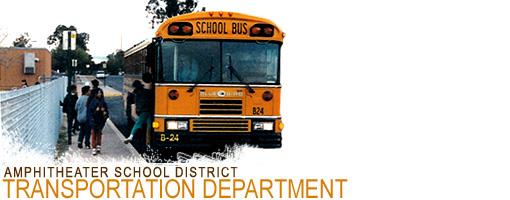- Amphitheater Public Schools
- Rules and Safety
Transportation Services
Page Navigation
- Overview
- Transportation Employment
- My Ride K-12 Mobile App
- Transportation Cancellation-Reschedule
- Bus Stop Finder/School Search
- Contact Information
- Did You Know?
- Bus Stop Concern/Request Form
- Letter to Parents
- Rules and Safety
- Special Needs Transportation
- Web Resources
- When to Stop for the Bus
- Bus Pass
-

Young people were first transported to school at public expense in the late 19th century - first in horse-drawn wagons and later in converted trucks. By the '20s and '30s, the first vehicles designed specifically for pupil transportation became available. Yet safety continued to be a concern, culminating in 1936 in the first set of national school bus standards.
"School bus transportation continues to be one of the safest forms of transportation" according to the National Highway Traffic Safety Administration. It's far, far safer to ride in a yellow bus than in the family car, for instance. This superb record is the result of a consistent cooperative effort by a host of individuals and groups. Everyone with a stake in student transportation - parents, teachers, drivers, school administrators, transportation managers, bus manufacturers and government officials - has a role to play.
School buses and other district vehicles are provided as a service to district students and persons responsible for the students. In order to ensure the safety of all passengers, proper conduct is required. Video taping will occur at random during the school year on routes. Students will not be notified when a recording device has been installed and is in use. Additional disciplinary rules are contained in the District's Student Code of Conduct. Remember, school bus transportation is a privilege, not a right; school bus transportation can be suspended for willful misconduct or endangering the overall safety of the school bus or its occupants.Passenger Rules
When riding in a school bus or other district vehicle each passenger should:
- Comply with the driver's directions.
- Treat driver and other rides with respect at all time.
- Not use loud, rude, profane or obscene languages or gestures.
- Remain seated while vehicle is in motion.
- Keep all personal possessions under control at all times.
- Keep bus aisles free of obstruction.
- Keep unauthorized materials and substances off school buses. This includes animals, glass objects, weapons, radios, etc.
- Not eat or drink any kind of food or beverage unless approved by driver.
- Wear your seatbelt.
If the rules are not followed, the driver has the authority to administer consequences based on the severity of the disruption. The school Principle and person responsible for the students will be consulted when the driver judges the offense as serious (level 3) or very serious (level 4).
- Level 1: Minor violations, firsttime offenses, no safety problem -- Consequence: Verbal warning
- Level 2: Moderate severity Repeat violation, conduct distracts driver -- Seat assignment
- Level 3: Serious or multiple violations Disruptive safety problem which compromises safety or welfare of drivers and riders -- Bus conduct report , administrator and parent contact required. No more than 2 conduct reports may occur at 3rd level before suspension of riding privileges occur.
- Level 4: Very serious Vandalism, drugs, alcohol, weapons, assault -- Consequences: Bus conduct report, suspension of riding privileges. Additional 4th level offenses may result in suspension from bus for remainder of the year.

